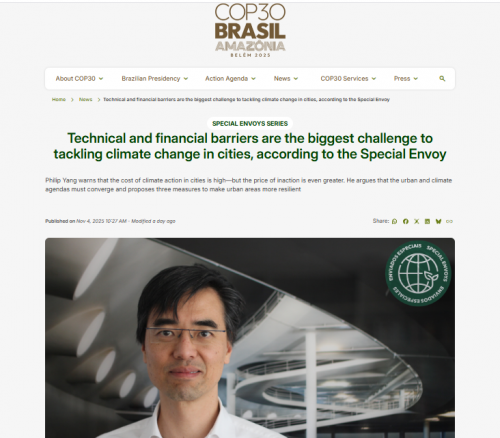
By Bárbara Bezerra and Laura Marques/COP30
The high cost of climate adaptation measures in cities, and the lack of technical capacity at the municipal level to implement them, are crucial issues that must be addressed at COP30, according to Mr. Philip Yang, Special Envoy for Urban Solutions. The former diplomat and founder of Institute of Urbanism and Studies for the Metropolis (Instituto de Urbanismo e Estudos para a Metrópole/URBEM) acknowledges that investments in drainage systems, river restoration, and slum urbanization are costly. Yet, he warns that the cost of inaction is far higher.
“It materializes in the economic losses caused by every flood, in service interruptions, and in the public health impacts of extreme heat. Each extreme event erodes our economy—beyond the human losses, which are immeasurable,” he said.
Mr. Yang proposes three paths to untangle the web of issues behind these bottlenecks: establishing a formal arrangement between the United Nations Framework Convention on Climate Change (UNFCCC) and UN-Habitat; creating a subnational financing window supported by a catalytic project-preparation fund; and deepening the integration of the urban agenda into COP policy decisions.
Challenges and Solutions
According to the Special Envoy, most climate adaptation projects do not generate direct revenue. As a result, their implementation costs fall to governments that already face fiscal constraints—both in developed and developing countries. This gap, he argues, could be addressed through a catalytic fund, an investment mechanism designed to stimulate sectors deemed too risky for conventional investors.
“The bottleneck lies at the start of the pipeline: without studies, permits, and engineering, there is no public or private decision-making. The fund fills this market and government failure, structures a bankable pipeline, and attracts development banks and private capital,” he explained.
At the same time, many municipalities still lack the technical capacity to design and manage complex projects. Mr. Yang stresses the importance of strengthening coordination among national, state, and local governments. “Federal regulations and resources should organize the ‘how,’ states should provide technical and co-financing support, and municipalities should deliver on the ground. When this cycle works in a feedback loop, reinforcing knowledge across levels, results emerge—and last,” he noted.
One of the Special Envoy's goals at this COP is integrating the climate and cities agendas. He believes that uniting the UNFCCC and UN-Habitat is essential to achieving this goal. "This would anchor the New Urban Agenda in the climate regime, increase the efficiency of both organizations, and open an institutional door for states and municipalities in the multilateral process. This establishes the link between climate and cities through governance with rules, mandates, and accountability."
Good practices
Mr. Yang points to several examples showing that, where cities plan, use data, and strengthen governance, they respond more effectively to heat, flooding, and rising sea levels.
“Curitiba uses wetland parks to absorb floodwaters. São Paulo combines retention reservoirs with linear parks along micro-basins. Rio de Janeiro operates real-time rainfall alerts. Medellín reduced heat islands with green corridors. Rotterdam created ‘water squares’ that double as retention basins during heavy rain. Copenhagen redesigned its streets to safely channel stormwater. This is the nexus between climate and cities becoming tangible projects—implementation at last,” he explained.
Expectations
Mr. Yang hopes COP30 will be a turning point—accelerating and consolidating efforts to build urban resilience that are already underway. He envisions closer integration among local governments and the network of NGOs supporting local climate action within COP discussions. Such progress, he suggests, could be achieved by embedding the Local Governments and Municipal Authorities (LGMA) Constituency and the Coalition for High Ambition Multilevel Partnerships (CHAMP) more deeply into the UN system.
“If that turning point happens, Belém will be remembered not only as the ‘COP of the Forest,’ but also as the ‘COP of Cities’—cities with less flooding, less extreme heat, more green jobs, and the foundations of a new, sustainable economy,” he emphasized.









